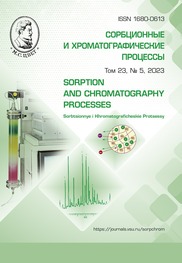Адсорбционные свойства поверхности Силохрома С-80, модифицированного ализаринатом алюминия
Аннотация
Материалы на основе кремнеземов находят широкое применение в процессах концентрирования и разделения различных органических веществ. Успешное использование SiO2 обусловлено его химической стойкостью, термической стабильностью, природой и распределением функциональных групп на поверхности, а также возможностью создания на его основе материалов с определенными текстурными характеристиками, которые регулируются условиями синтеза и модифицированием поверхности. Для решения конкретных задач хроматографии необходимо получать новые адсорбенты с закрепленными функциональными группами, слоями или элементами, путем варьирования которых меняется число и типы адсорбционных центров исходной поверхности. В качестве перспективных модифицирующих добавок, представляющих особый интерес, применяют хелатные комплексы переходных металлов, в том числе нанесенных в виде адсорбционных слоев. В данной работе изучен физико-химическими методами SiO2 на основе Силохрома С-80, модифицированный ализаринатом алюминия. Термогравиметрией установлено, что ализаринат алюминия устойчив до 270°С. С помощью адсорбционной порометрии показано, что модифицирование кремнезема приводит к снижению средних диаметров и суммарных объемов пор, площадей удельной поверхности от 84 до 79 м²/г. Методами ИК и КР-спектроскопии доказано закрепление хелатов на поверхности Силохрома.
Газохроматографическим методом изучены процессы адсорбции органических соединений (н-алканов, нитрометана, гептена-1, ароматических углеводородов, кетонов и спиртов), способных к различным типам межмолекулярных взаимодействий. Модифицирование кремнезема ализаринсодержащим комплексом способствует изменению констант Генри адсорбции, вкладов специфических взаимодействий в теплоту адсорбции. При этом наибольшие значения ∆ q̅dif,1(спец) характерны для органических соединений, склонных к донорно-акцепторному и π- комплексообразованию.
Согласно анализу компенсационных термодинамических зависимостей q̅dif,1 - ∆S̅S1,c показано, что энтропия является определяющим термодинамическим параметром при адсорбции тестовых соединений на поверхности исследуемых хроматографических материалов.
Скачивания
Литература
Lisichkin G.V. Himija Privitykh Poverhnostnykh Soedinenij. M., Fizmatlit, 2003: 592 p. (In Russ.)
Gavrilenko M.A., Slizhov Yu.G., Faustova Zh.V., Kasymova T.A., Sol-Gel Synthesis of Chelate Containing Materials for Gas Chromatography. Advanced Materials Research, 2014; 1040: 448-452.
Rodinkov O.V., Karpov D.S., Postnov V.N., Moskvin L.N., Kompozicionnye gidrofobnye sorbenty dlya koncentrirovaniya letuchih organicheskih veshchestv iz vodnyh rastvorov. Vestnik SPb un-ta, 2007; 4(4): 77-83.
Zolotov Yu.A. Razdelenie i koncentrirovanie v himicheskom analize. Russian Chemical journal, 2005; 49 (2): 6-10. (In Russ.)
Patrushev Yu.V., Sidelnikov V.N. The properties of capillary columns with silica organic-inorganic MCM41 type po-rous layer stationary phase. J. Chromatog. A, 2014; 1351: 103-109. https://doi.org/10.1016/j.chroma.2014.05.042
Gavrilenko M A. Diss. cand. chem. nauk. Tomsk, 2016, 302 р. (In Russ.)
Onuchak L.A., Burmatnova T.S., Stepanova R.F., Kuraeva YU.G., Tyurina E.S. Sorbcionnye i selektivnye svojstva kompozicionnogo sorbenta na osnove ev-tekticheskoj smesi nematicheskih zhidkih kristallov i metilirovannogo β-ciklodekstrina. Zhidkie kristally i ikh prakticheskoe ispol'zovanie. 2011; 1 (35): 85-90.
Gus'kov V.Yu. Diss. cand. chem. nauk. Ufa, 2012, 140 p.
Karcova L.A., Bessonova E.A., Kolobova E.A. Ionnye zhidkosti – modifikatory hromatograficheskih i elektroforeticheskih system. J. of Analytical Chemistry, 2016; 71 (2): 147-158.
Pahnutova E.A., Slizhov YU.G. Issledovanie adsorbcionnyh svojstv pover-hnosti Silohroma S-80, modificirovannogo alizarinatami metallov. Sorbtsionnye i khromatograficheskie protsessy. 2022; 22(3): 299-309. https://doi.org/10.17308/sorpchrom.2022.22/9336
Soubayrol P., Dana G. Aluminium-27 solid-state NMR study of aluminium coordination complexes of alizarin. Magnetic resonance in chemistry, 1996; 34: 638-645. https://doi.org/10.1002/(SICI)1097-458X
(199608)34:8<638::AID-OMR926>3.0.CO;2-5
Zhu L., Bai Y.-L., Zhao Y., Xing F., Li M.-X., Zhu S. Bis(2-pyridylmethyl)amine-functionalized aliza-rin: an efficient and simple colorimetric sensor for fluoride and a fluorescence turn-on sensor for Al3+ in an organic solution. J. Dalton Transaction. 2019; 48 (15): 5045-5047. https://doi.org/10.1039/c9dt00859d
Zhuang G., Pedetti S., Bourlier Y., Jonnard C., Méthivier P. Walter А., Pradier C.-M., Jaber M. New Insights into the Structure and Degradation of Alizarin Lake Pigments: Input of the Surface Study Approach. J. Phys. Chem., 2020; 124 (23): 12370-12380. https://doi.org/10.1021/acs.jpcc.0c00746
Marzec A., Szadkowski B., Rogowski J., Maniukiewicz W., Szynkowska М., Zaborski M. Characteristics of Hybrid Pigments Made from Alizarin Dye on a Mixed Oxide Host. Materials, 2019, 360 (12): 1-14. https://doi.org/10.3390/ma12030360
Fain, V.Y., Zaitsev B.E., Rabov M.A. Metal complexes with 1,5- and 1,8-dihydroxy-9,10-anthraquinones: Electronic absorption spectra and structure of lig-ands. Russ. J. Coord. Chem., 2004; 30: 360-364. https://doi.org/10.1134/S1070328406080136
Marzec A., Szadkowski B., Rogowski J., Maniukiewicz W., Mozynski D., Zaborski M. Characterization and prop-erties of new color-tunable hybrid pigments based on layered double hydroxides (LDH) and 1,2-dihydroxyanthraquinone dye // Journal of Industrial and Engineering Chemistry, 2019; 70: 427-438. https://doi.org/10.1016/j.jiec.2018.11.005
Supina VA. Nasadochnye kolonki v gazovoj hromatografii. M. Mir. 1977. 257 p.
Makarycheva A.I. Diss. kand.him.nauk. Tomsk, 2018, 185 p. (In Russ.)
Parkaeva S.A., Belyakova L.D., Revina A.A, Larionov O.G. Adsorbcionnye svojstva kremnezema, modificirovannogo stabil'nymi nanochasticami palladiya, po dannym gazovoj 180 hromatografii. Sorbtsionnye i khromatograficheskie protsessy, 2010; 10 (5): 713-722. https://journals.vsu.ru/sorpchrom/article/view/2100
Ershov A.V., Mashin A.I., Karabanova I.A. Izuchenie kolebatel'nyh svojstv amorfnogo kremniya metodom IK-spektroskopii. N. Novgorod: NNGU. 2007, 24 p. (In Russ.)
Kolesov B.A. Prikladnaya KR-spektroskopiya. Novosibirsk, Izd-vo SORAN, 2018, 389 p.
Minakova T.S. Adsorbcionnye pro-cessy na poverhnosti tverdyh tel. Uchebnoe posobie. Tomsk: Izd-vo Tom. un-ta, 2007, 284 p.
Suhareva D.A., Gus'kov V.YU., Karpov S.I., Kudasheva F.H., Roessner F., Borodina E.V. Polyarnost' poverhnosti modificirovannogo metil'nymi i fenil'nymi gruppami adsorbenta MSM-41 po dannym gazovoj hromatografii. Russ. Journal of phys. chem., 2016; 90 (2): 285-289. https://doi.org/10.7868/S0044453716020291 (In Russ.)
Faustova ZH.V., Pahnutova E.A., Matveeva T.N, Slizhov YU.G., Ad-sorbcionnye svojstva poverhnostnyh sloev silikagelya, modificirovannyh acetilacetonatami perekhodnyh metallov. Vestn. MGTU im. N.E. Baumana. Ser. Estestvennye nauki, 2018; 77 (2): 114125. https://doi.org/10.18698/1812-3368-2018-2-114-125 (In Russ.)








